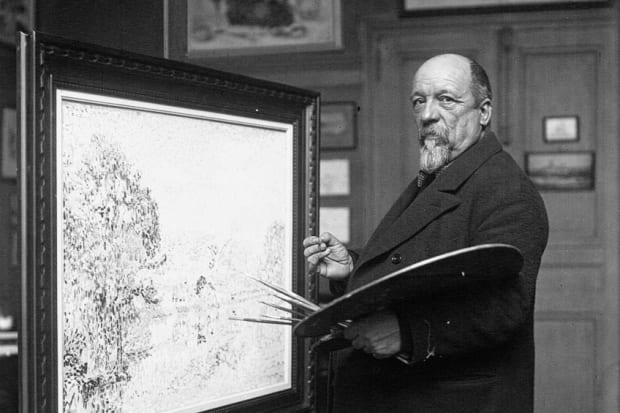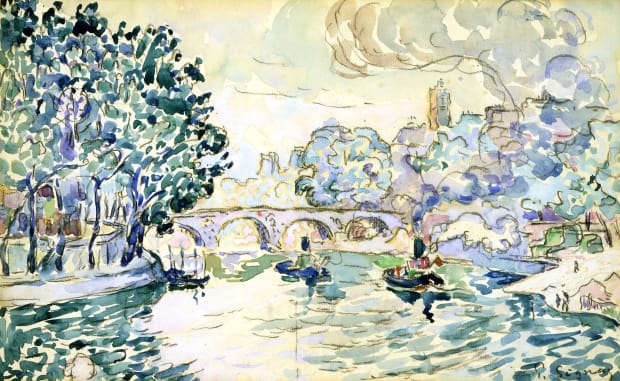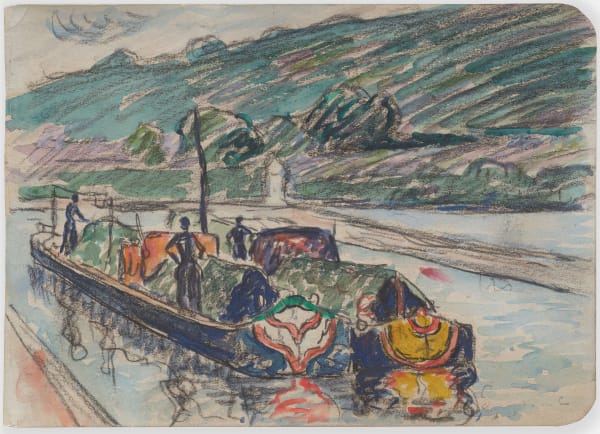-

-
The Discovery of Watercolour
-
“Oil painting is a serious battle, watercolour a playful game” (Paul Signac)
-
An avid sailor, Signac was predominantly known for his vibrant paintings of seascapes and ports. It was Pissarro who urged him to try the medium of watercolour, understanding how the practicality and uniqueness of the medium would be beneficial to his friends’ artistic practice.
-
In just a few minutes you can take notes that would be impossible by other means – the fluidity of the sky, some transparent effects, a mass of small pieces of information that cannot be conveyed working slowly [ Pissarro to Signac in a letter dated August 30th 1888]
-
It wasn’t until some years later, in 1892, after the death of Seurat, his partner in Pointillism, that he heeded his friend Pissarro's advice and made his first proper trials in watercolour. It was during one of his many trips on his boat L’Olympia, and after a few initial attempts, by the time he got to his destination in the South of France and whilst awaiting his painting equipment, he got to grips with the medium. Showing a remarkable aptitude for the medium, he was ‘immediately capable of exploiting its possibilities’ (Marina Ferretti Bocquillon, Paul Signac, a collection of watercolors and drawings, p.14, Ed. Abrahams Inc., New York, 2000 ), henceforth replacing his pencil studies in favour of watercolour to better convey the landscapes and light of the French south in colour.
Around this time Signac renounced the use of oils for Plein air painting, preferring watercolour as the intermediary medium. This allowed him to travel unburdened by equipment, to record the wonders he saw, the effects of light, colours and then use his notes when back in the studio to produce the more methodical, intellectual works in oils. He left a colourful trail of his travels in his carnets and his letters to friends which he would annotate with watercolour.
-

-

-
Paris
-
Paris
Signac was born and raised in Paris and lived in several different parts of the city at different periods of his life. As an adult, he tended to spend the summer months travelling and sailing and the colder months back in Paris in the studio. The city remains one of his recurring motifs. -
In 1910, he undertook a series of works on paper which were exhibited at the Galerie Bernheim-Jeune. He made full use of of his transition to watercolour, depicting with flair Paris, from street scenes to the Seine and its bridges, fully able to use the freedom of this medium and its qualities.
-
Brittany
-
An enthusiastic sailor, Signac travelled on many occasions to Brittany and Normandy in northern France, usually sailing on his boat, l’Olympia. From 1924 through to 1930, he spent his summers at Lézardrieux in Brittany and in 1931 he bought a property in Barfleur, Normandy. Harbours and boats had long held a fascination for him and were a constant source of inspiration for his painting. He would spend many contented hours sketching by ports and quaysides and once he had mastered the use of watercolour he saw no need to take anything else with him other than his pocket paints and a notebook, painting fluidly and with ease, finding a harmony in the pure colours.
-

-

-

Paul Signac
Goélettes à Paimpol, c.1927Watercolour and drawing on paper
19 x 24.7 cm
7 1/2 x 9 ¾ inches -
Port de France series
-
Signac travelled up and down the coast of France from 1929 to 1931, a project of his own design he had long dreamt of. His objective was to sail on his boat to one hundred harbours in France, painting watercolours in each location. Wanting to involve his friend the collector Gaston Lévy, he offered that he would make two watercolours of each port, one for Levy and one for himself. Levy commissioned the project. Signac had originally planned for there to be an exhibition of the works, and even asked his friend Henri van de Welde to produce it, however, most of the works ended up being distributed to Gaston Levy and his cousin André Levy, also a friend and neighbour to Signac in St. Tropez. They were kept in bound albums, protected from the light and remained unpublished until their sale in 1995.
-
Johan-Barthold Jongkind
-
Signac had long admired the work of Johan-Barthold Jongkind and was a collector of his watercolours. They had a shared affinity with water and boats. In 1899, Bernheim-Jeune held an exhibition of over 50 of Jongkind's watercolours which left a deep impression on Signac, who wrote several pages on the works in his journal.
Signac appreciated Jongkind's subtle technique, his shimmering style which translated the energetic and emotional character of the scenes he depicted.
In 1927, he published a monograph on the artist, with particular focus on his watercolours and drawings.
Françoise Cachin pointed out that when he writes about Jongkind as a watercolourist, he is, in fact, writing a virtual treatise on the art of watercolour (Françoise Cachin, P.Signac, Paris, Bibliothèque des Arts, 1971, p.116)
-
-

Paul Signac, Jongkind, 1927, Editions Crès, Courtesy Gallica, Bibliothèque Nationale de France
-

Paul Signac, Jongkind, 1927, Editions Crès, Courtesy Gallica, Bibliothèque Nationale de France
-
-
‘[…] from 1863, with motifs of Honfleur, d’Anvers, de Rotterdam, Paris and surrounding areas, starts the most beautiful series of of watercolours in the world.’ ( Signac about Jongkind series of Watercolours)
-
-
 Johan-Barthold JongkindBateaux en rade de Honfleur, 1865Signed lower centre Jongkind Dated and located lower right Honfl 12 Sept 65Watercolour and charcoal on paper31 x 52 cm
Johan-Barthold JongkindBateaux en rade de Honfleur, 1865Signed lower centre Jongkind Dated and located lower right Honfl 12 Sept 65Watercolour and charcoal on paper31 x 52 cm
12 ¼ x 20 ¼ inches -
 Johan-Barthold JongkindLe Port d’Honfleur, 1865Signed and dated lower right Jongkind, Honfl. 23 Sept 1865Watercolour14.5 x 23 cm
Johan-Barthold JongkindLe Port d’Honfleur, 1865Signed and dated lower right Jongkind, Honfl. 23 Sept 1865Watercolour14.5 x 23 cm
5 ¾ x 9 inches
-
-
In Jongkind he recognised a kinship in his use of light and colour in the medium of watercolour, down to the effect of leaving the white of the paper to show through the paint and also leaving gaps in the paint revealing white paper, leaving the colours to reveal their intensity and synthesize.
-
Artworks

















